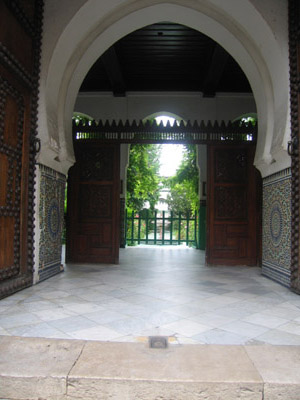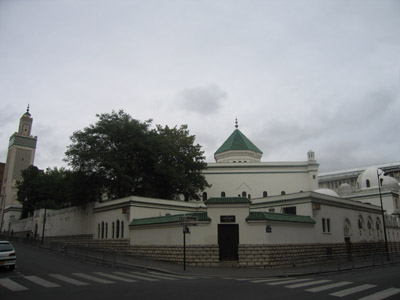
DECEMBER 2005
A TV documentary
"A Forgotten Resistance: The Paris Mosque,"  by Derri Berkani
by Derri Berkani
During the German occupation of World War II the Paris
mosque was a refuge for Jewish children and others fleeing the Nazis. Kaddour
Benghabrit, rector of the mosque, taught that Islam
required believers to provide shelter and protection to
all who were in trouble, whatever their religion. In the
course of the war, over 1,700 Jews and Resistance
fighters were hidden in the spacious grounds of the
mosque, and not one asylum seeker was captured.
and others fleeing the Nazis. Kaddour
Benghabrit, rector of the mosque, taught that Islam
required believers to provide shelter and protection to
all who were in trouble, whatever their religion. In the
course of the war, over 1,700 Jews and Resistance
fighters were hidden in the spacious grounds of the
mosque, and not one asylum seeker was captured.
On July 16 and 17, 1942, nearly 13,000 Jews—4,000 of
them children—were rounded up in Paris to be sent to
concentration camps. Only 30 survived the war, none of
them children. Those who escaped the initial dragnet
remained in constant danger.
| ..............the Vichy French police
separated the children from their parents. The
parents were then transported to Auschwitz to be
gassed. The children followed soon after. When
the Red Army liberated Auschwitz on January 26,
1945, they found 2,819 inmates still alive but
only thirty of the 6,900 non-French Jews were
alive. Sadly, none of the 4,051 children
survived. George Duncan's site on massacres and atrocities of WW2 |
While conducting research for his film, Berkani
discovered a leaflet that was distributed among Algerian
Muslims in Paris at that time. It expresses, simply but
eloquently, the sense of solidarity that bridged the
religious divide:
Yesterday, at dawn, the Jews of Paris were arrested—the old people, the women, and the children. They are in exile like us, workers like us. They are our brothers, and their children are our children. If any of you see these children, you must give them asylum and protection, for as long as these times of misfortune last.
Annette Herskovits was one of those children who survived. Her parents—Romanian Jews who had migrated to France in the 1920s—were among those who died in Auschwitz. At age five, she hid in a Paris hotel room while the building next door was demolished by Allied bombs, and she endured the screams of trapped victims for days. Her teenage brother cleverly contacted a clandestine network similar to the one described in Berkani's film, and she was rescued to survive the war.
Herskovits is now a committed activist, and she has been working recently to help increase understanding between Arabs and Jews. She pointed out, for example, that many Israelis think of all Palestinians as terrorists, though nonviolent protest against the occupation is common. In Bilin, a village near Ramallah, the nonviolent demonstrations are unusually creative as Mohammad Daraghmeh writes in the Daily Star (Beirut):
The first demonstration was restricted to women, and aimed to convey that they came to protest peacefully.… The second demonstration was restricted to children.
When occupation forces started bulldozing land and uprooting olive trees, the villagers expressed their attachment to their trees, some of which were more than a hundred years old, by tying themselves to those about to be uprooted. The villagers succeeded in delaying the soldiers' work for over five hours while soldiers cut the chains connecting people to their olive trees.
Next, participants entered drums that close from the inside, showing their head only, and tied themselves to the trees. Another time, villagers surprised the soldiers with a march of white coffins, each carrying the name of a respected value, such as justice, humanity, rights, manners, etc. Once demonstrators taped their mouths shut while flying the flags of countries that are active in the international arena - symbolizing international silence towards the suffering of the Palestinian people.
| Daily Star, further excerpts Organizers of such activities state that they have achieved better results than others using violent methods. Abu Rahmeh stated: "These demonstrations have attracted large numbers of Israeli and foreign supporters and directed media coverage at what we do and what we suffer from. Had our demonstrations concentrated on stone-throwing, no supporters or media would have joined us. But through innovative new forms of peaceful resistance, everyone wants to learn these forms and make them succeed." News of the peaceful methods utilized by the villagers of Bilin has echoed throughout Israeli society. One newspaper referred to the villagers of Bilin as "the new Ghandists." This had a noticeable impact on soldiers, who reduced levels of violence in the face of non-violent demonstrations in which an increasing number of their own compatriots are participating. The Israelis also replaced bullets with less damaging anti-demonstration tools, such as tear gas, electric batons and powerful loud-speakers, which people avoid. The Bilin villagers' methods have started to expand into other areas threatened with land expropriation, the wall and settlement. As Abu Rahmeh observes: "We have recently received invitations from the villagers of Murda and from the tribes of Ramdaniyyeen to help them organize popular demonstrations that attract the media and foreign and Israeli supporters and reduce violence." This may well be a new stage in the Palestinian people's struggle against Israel's occupation. |
These are times of misfortune for both
Israelis and Palestinians. Protests, even nonviolent
protests, are no substitute for a spirit of brotherhood
and a shared desire for peace. Let us hope that both
sides will embrace the words of those Algerian Muslims 60
years ago about the Jews of Paris: "They are our
brothers, and their children are our children."
www.robertsilvey.com

Other work by Derri Berkani:
**********************************
L’ACB Ouvre les Guillemets à Derri Berkani le 3/11/04
pour son livre : " Le tournesol fou " mis en ligne le mercredi 3 novembre 2004
Les années 58-59 sont une période noire et méconnue de la guerre de libération. Une vaste purge est menée, visant à éliminer tous les intellectuels des rangs de l’ALN : la "Bleuite". Alilou Jebbi, étudiant algérois devenu maquisard en Kabylie, sur le point d’être exécuté par ses compagnons, réussit à leur échapper. A Mizane, ville où il croit trouver la "paix des braves" promise par l’armée française, il découvre l’autre face de la guerre avec ses tortures, ses exactions, ses exécutions sommaires. Dès lors qu’il refuse une collaboration directe, il devient la cible des deux camps, et visé par deux attentats, prêt à céder à la vieille loi du talion, il rencontre Nadia. Sa chance.
Soirée animée par Arezki Metref.